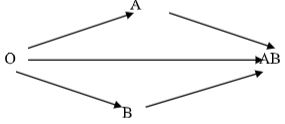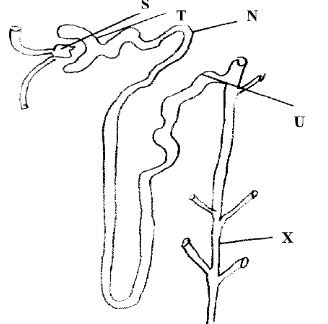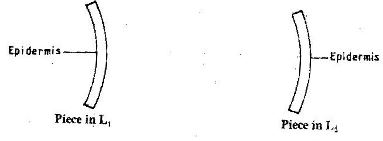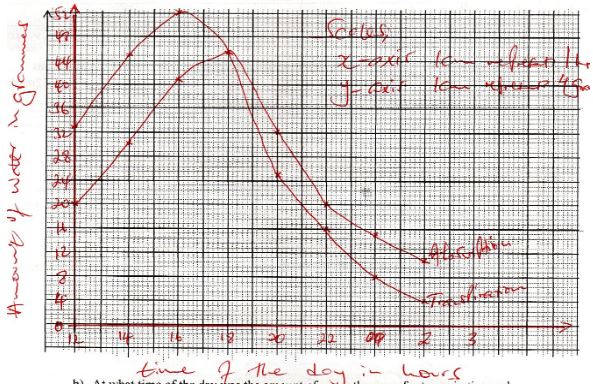- Answer all questions in section A
- In section B answer question 6 (compulsory) and either question 7 or 8
- The diagram below shows three different types of neurons along a reflex arc.
- Identify the Neuron labelled 1,2 and 3. (3mks)
- Using arrows show the direction of impulse transmission on the diagram. (1mk)
- Name the part where the cell body of neurons 1 and 2 are located. (2mks)
- Describe the transmission of impulses across the part labelled T. (2mks)
- The flow chart below shows blood transfusion pathway
- What five conclusions can you draw from the flow chart? (5 mks)
- Why is the knowledge of blood groups necessary before blood transfusion? (1 mk)
- Apart from knowledge of blood groups state two precautions that must beobserved during blood transfusion. (2 mks)
- The diagram shown below is a section through the mammalian nephron.
- Name parts :- (2mks)
- T…………………………………………………………………………………
- U…………………………………………………………………………………
-
- Name one hormone that has an effect on part labelled X and where is it produced (2mks)
- How will the concentration of urine be affected at region U in the absence of hormone referred to in (ii) (a) above. (1mk)
- Name the fluid formed in part labelled T. (1mk)
- Which conditions are responsible for formation of fluid at part labelled T. (2mks)
- Name parts :- (2mks)
- The genetic disorder haemophilia is due to a recessive sex linked gene. A man who is haemophilia married a woman who is a carrier for the condition.
- Using the letter (H) to represent the normal condition and (h) for the haemophiliac condition.
- What is the genotype of the man and woman? (1 mk) Man…………………………………………………………………………………………
Woman…………………………………………………………………………………… - Work out a cross between the man and woman. (4 mks)
- What is the genotype of the man and woman? (1 mk) Man…………………………………………………………………………………………
- What is the chance that both the first and second sons will be haemophiliac? (2 mks)
- Haemophilia is more common in males than in female humans. Explain. (1 mk)
- Using the letter (H) to represent the normal condition and (h) for the haemophiliac condition.
- A freshly obtained Tradescantia stem measuring 5 cm long was split lengthwise to obtain two similar-pieces. The pieces were placed in solutions of different concentrations in Petri dishes for 20 minutes.
The appearance after 20 minutes is as shown- Account for the appearance of the pieces in solutions L1 and L2( 6 mks)
- State the significance of the biological process involved in the experiment ( 2 mks)
SECTION B(40 MKS)
Answer question 6 (Compulsory) and either question 7 or 8 in spaces provided.
- An experiment was carried out to investigate transpiration and absorption of water in sunflower plants in their natural environment with adequate supply of water. The amount of water was determined in two hour intervals. The results are shown in the table below.
Time of day Amount of water in grammes Transpiration Absorption 11:00 - 13:00 33 20 13:00 - 15:00 45 30 15:00 - 17:00 52 42 17:00 - 19:00 46 46 19:00 - 21:00 25 32 21:00 - 23:00 16 20 23:00 - 01:00 08 15 01:00 - 03:00 04 11 - Using the same axes, plot graphs to show transpiration and absorption of water in grammes against time of day. (7mks)
- At what time of day was the amount of water the same for transpiration and absorption? (1 mark)
- Account for the shape of graphs of:
- Transpiration (3marks)
- Absorption (3 marks)
- What would happen to transpiration and absorption of water if the experiment was continued untill 05.00 hours? (2 marks)
- Name two factors that may affect transpiration and absorption at any given time. (2 marks)
- Explain how the factors you have named in (e) above affect transpiration. (2 marks)
-
- Explain how the gills of fish are adapted to the process of gaseous exchange.(5 marks)
- Describe how gaseous exchange occurs in leaves of a terrestrial plant. (15 marks)
- How is the mammalian eye adapted to its functions?(20marks)

MARKING SCHEME
-
-
- 1 motor / efferent Neuron ;
- 2 Relay / intermediate Neuron ;
- 3 Sensory Neuron:
- Towards the motor Neuron from the sensory
- Grey matter rej any other ;
- Impulse reaching the dendrite end of relay / Neurons ; causes the synaptic vessels to release acetylcholine / transmitted chemical ; which diffuse a cross the cleft and causes the depolarisation of the motor Neuron; 2 x 1 = (2mks)
-
-
-
- Blood group O is a universal donor as it donates to all other blood groups;
- Blood group AB is a universal recipient as they receive blood from blood from all other groups.
- Blood group A can receive blood from blood group O and A only.
- Blood group B can receive blood from blood group O and B only.
- Blood group O does not receive blood from other blood groups except group O.
- To avoid agglutination/clumping of red blood cells.(1 mark)
- Blood does not have pathogens. The Rhesus factor matches; (2 marks)
-
-
-
- T - Bowman’s capsule;
- U – Collecting tubule ; (2mks)
-
- Antidiuretic hormone/Vasopressin (2mks)
- Where produced-Pituitary gland ; (2mks)
- Dilute urine formed ; (1mk)
- Glomerular filtrate // capsular fluid ; (1mk)
-
- Narrower efferent arteriole
- High pressure from pumping action of heart.
- Narrow glomeruli capillaries
- Tiny pores in capsular wall // endothelium of glomeruli; Any 2 (2mks
- Antidiuretic hormone/Vasopressin (2mks)
-
-
-
- Man – XhY;
Woman – XHXh; - Parental phenotype carrier woman Haemophilia man
parental genotype XHXh X XhY;
N/B (Penalise for gametes if they are not circled & If fusion lines do not intersect)
- Man – XhY;
- ¼ x ¼ = 1/16 (2 mrks)
- Male requires defective gene to be haemophilic;(Because Y chromosomes does not have the corresponding allele; for the gene that determine or cause haemophilia/Y chromosome is almost genetically empty.)
-
-
-
- L1 - Inner cells gained water by Osmosis; hence increased in length; epidermal cells did not gain water because they are covered by a water proof cuticle leading to curvature.
- L2 - Inner cells lost water by osmosis; leading to (flaccidity) decrease in length; epidermal cells did not lose water due to waterproof leading to curvature
-
- Absorption of water by the roots
- Opening and closing of the stomata
-
-
- Using the same axes, plot graphs to show transpiration and absorption of water in Grammes against time of the day. (7 marks)
Scales - 2 mks Axis – 2mks Curve – 2maks Identify - 1mk = 7mks - At what time of the day was the amount of water the same for transpiration and absorption. (1mark)
- 18hours
- Account for the shape of the graph of;
- Transpiration (3marks)
- Rate of transpiration increases from 12hours to 16 hours, reaches its peak and 16 hours and decreases form 16hours to 2 hours. Increase in temperature increases latent heat of vaporization hence increasing transpiration. Decrease in temperature reduces latent heat of vaporization hence les transpiration.
- Absorption (3marks)
- Rate of absorption increase from 12hours to 16 hours, reaches its peak at 16 hours and decreases form 16 hours to 2 hours.
- The higher the temperature, the higher the rate of transpiration hence the higher the rate of absorption in order to replace lost water.
- The lower the temperature the lower the rate of transpiration, hence the lower the rate of transpiration since less water is needed for replacement.
- Transpiration (3marks)
- What would happen to transpiration and absorption of water if the experiment was continued till 0500 hours? (2marks)
- Both transpiration and absorption would decrease. The rate of absorption would exceed the rate of transpiration.
- Name two factors that would affect transpiration and absorption at any given time. (2marks)
- Temprature/humidity/light intensity/wind
- Name the tissues in plants responsible for; (2marks)
- Transport of carbohydrates
- Phloem
- Primary growth
- Apical meristem
- Transport of carbohydrates
- Using the same axes, plot graphs to show transpiration and absorption of water in Grammes against time of the day. (7 marks)
-
-
- Gill bar or gill arch is long and curved to provide a surface for attachment of gill rakers and gill filaments.
- Gill filaments-numerous and long to provide a large surface area for gaseous exchange.
- Gill filaments-are covered by a thin epithelium that shortens the distance to be covered by respiratory gases.
- Gill filaments-are supplied with a dense network of blood capillaries for the transportation of respiratory gases.
- Gill rakers-teeth-like structures that are pointed to trap or filter solid particles present in water.
- Gill rakers-prevent solid particles from reaching the delicate gill filaments.
- Operculum-protects the gills on either side of the head.
- Gaseous exchange occurs in the spongy mesophyll; During the day, air diffuses into large air spaces of the spongy mesophyll; through the stomata; the carbon (IV) oxide in the air diffuses into photosynthetic cells; in solution form; during photosynthesis, carbon (IV) oxide is used up; while oxygen is produced; some of the oxygen is used in respiration; while the rest diffuses out of the leaf; through the stomata;
During the night, air diffuses into the air spaces; through the stomata; the air dissolves into the film of moisture; oxygen in the air diffuses into the cells; and is used for respiration; carbon (IV) oxide produced; diffuses out through stomata; due to a concentration gradient/diffusion gradient; At night, carbon (IV) oxide accumulates in the leaf since photosynthesis does not occur; some gaseous exchange also takes place through the cuticle; and through the epidermis of young leaves, roots and stems; some plants exchange gases through breathing roots/pneumatophores; older stems exchange gases through lenticels;
Max 15 mks
-
-
Sclera/sclerotic layer; white fibrous layer; made up of thick connective tissue; protects the eye; maintains shape of eyeball; Cornea; transparent; disc-shaped layer; that allows light to enter the eye; refracts light towards the retina;Conjunctiva; delicate membrane; lining the inside of the eyelid; protects the cornea/eye; Eyelids and eye lashes; thin muscle with hairs; protects the cornea/eye from mechanical/chemical damage/protects the eye from entry of foreign particles; protects retina from bright light; Choroid; dark pigmented and membranous layer; that prevents light reflection within the eye/absorbs light; to prevent distortion of the image; has blood vessels; that nourish eye/retina/supply oxygen/remove carbon (IV) oxide and wastes; extends to form the ciliary body and iris; Ciliary muscles; have elastic muscles that contract and relax; to alter shape/curvature of lens during accommodation; Ciliary body; thickened front edge of the choroids layer; that produces aqueous humour; Suspensory ligaments; made up of elastic connective tissue whose contraction and relaxation helps to adjust the shape of lens during accommodation/holds lens in position; Lens; transparent; biconvex; balloon-like; it refracts light rays/focus light onto the retina; Vitreous humour; nourishes cornea/lens; refraction of light; maintains eyeball shape; Iris; thin circular ring; with circular and radial muscles; it gives eye colour/absorbs light; controls the amount of light entering the eye/adjusts size of pupil;Pupil; an aperture through which light enters the eye; Retina; has photoreceptor cells/rods/cones for image formation; generates impulses to the brain for interpretation;Fovea/Yellow spot; with only cones; for high visual acuity/most sensitive part of the retinaBlind spot; point where nerve fibres emerge from the optic nerve/where optic nerve leaves eye/point where nerve fibres and blood vessels enter the eye; Optic nerve; transmits impulsesto the brain; Muscles; inferior and superior oblique muscles; move eye from left to right;superior and inferior rectus muscles; move the eye up and down; external and internal rectus muscles steady the eye in its up and down movement; Tear/Lachrymal glands; secrete a watery and saline fluid containing lysozymes/lytic enzymes/is antiseptic (tears); that moisten the conjunctiva and cornea; washes away dust and other foreign objects; kills microorganisms entering the eye;
Max. 20 mks
Download Biology Paper 2 Questions and Answers - ACK Diocese Mumias Joint Evaluation Mock 2022.
Tap Here to Download for 50/-
Get on WhatsApp for 50/-
Why download?
- ✔ To read offline at any time.
- ✔ To Print at your convenience
- ✔ Share Easily with Friends / Students






